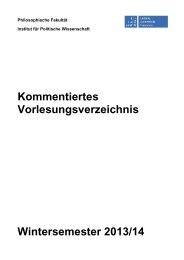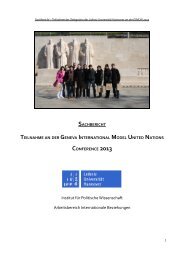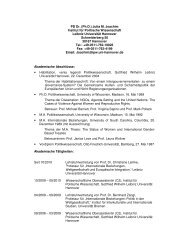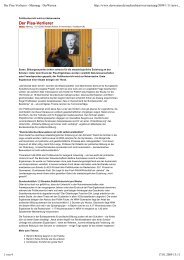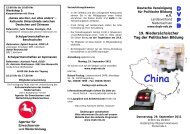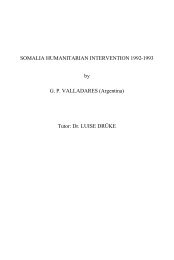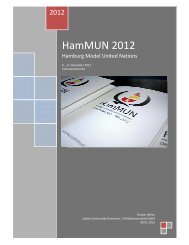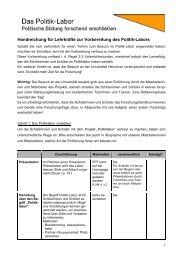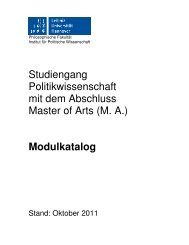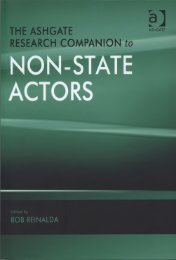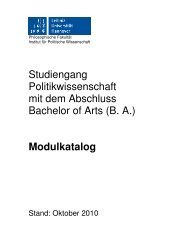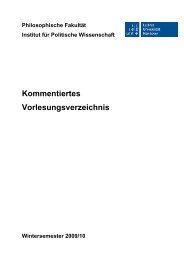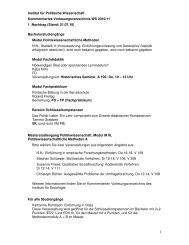Preventive Action for Refugee Producing Situations
Preventive Action for Refugee Producing Situations
Preventive Action for Refugee Producing Situations
You also want an ePaper? Increase the reach of your titles
YUMPU automatically turns print PDFs into web optimized ePapers that Google loves.
108 Chapter 3<br />
almost extinct; Garifondas (so-called Black Caribs); English-speaking<br />
Creoles, mainly in the South; and, in the second half of this century, mestizo<br />
(Hispanic) peasant migrants from the Pacific side of the country. 237<br />
This indigenous rural population, which has been living in stable village<br />
communities concentrated in the Mosquitia, is striving to preserve its<br />
threatened traditions and vanishing culture. Like lowland ethnic groups in<br />
many other countries, these indigenous people do not demand development<br />
and progress. Their struggles are not against unemployment or <strong>for</strong> Socialism.<br />
The native people of the Mosquitia rather struggle <strong>for</strong> the survival of their<br />
collective ethnic identity, their common language, a mythological geography<br />
and history, and collective land ownership, as well as the memory of an<br />
economy based on gift exchange, which was suppressed by the Protestant<br />
mission of Moravian priests in the recent history. 238<br />
After the Sandinista government came to power in 1979, it believed that<br />
the Indians should be "integrated into the national revolutionary mainstream<br />
through the mass organizations designed to promote class consciousness, and<br />
minimize the Indian's nationalist disposition. " 239 The new authorities<br />
prepared a national plan to implement their social and economic re<strong>for</strong>ms,<br />
which the indigenous populations rejected. Having suffered <strong>for</strong>ceful<br />
integration into the state of Nicaragua a century be<strong>for</strong>e, the Indian groups<br />
could not identify with the policies propagated by the new Nicaraguan<br />
government after 1979. 240 Both ALPROMISU (Alianza<br />
__________________________<br />
237 Martin Diskin, "The Manipulation of Indigenous Struggles," in Thomas Walker, ed.,<br />
Reagan versus the Sandinistas: The Undeclared War on Nicaragua, [hereinafter<br />
cited as "The Manipulation of Indigenous Struggles]," Westview Press, 1987, p. 83.<br />
238 Klaudine Ohland and Robin Schneider, "National Revolution and Indigenous<br />
Identity: The Conflict between Sandinistas and Miskito Indians on the Atlantic<br />
Coast" [hereinafter cited as National Revolution and Indigenous Identity], IW-GIA,<br />
No. 47, (Copenhagen, 1983), p. 9.<br />
239 Glenn T. Morris, "Between a Rock and a Hard Place - Left-Wing Revolution, Right-<br />
Wing Reaction and Destruction of Indigenous People, The Case of Mosquitia."<br />
Cultural Survival Quarterly, 11, No. 3 (1987), p. 19.<br />
240 It is worthwhile to note that the Mosquitia had its own history be<strong>for</strong>e 1860 as a part<br />
of the British Empire. With the Treaty of Managua of 1860 between Nicaragua and<br />
Great Britain, the British recognized <strong>for</strong> the first time Nicaragua's sovereignty over<br />
the Atlantic Coast In 1894 Nicaragua occupied the Mosquitia militarily and<br />
incorporated it into its national territory as one of the departments. In a similar<br />
treaty, Honduras was given a small pan of the Mosquitia. This resulted in the<br />
division of the Mosquitia and produced a 100-year-long border dispute, which was<br />
resolved only in 1960 by the International Court of Justice which defined the<br />
Analytical Discussion 109<br />
de Progreso de los Miskitos y Sumos, or Alliance [<strong>for</strong> the Progress of]<br />
Miskito and Sumo Development) and SUKUWALA (Asociacion Nacio-nal<br />
de Comunidades Sumu) were established in the early 1970s to expand<br />
activities <strong>for</strong> Indian self-determination. In November 1979, hardly four<br />
months after the Nicaraguan revolution, Daniel Ortega met with representatives<br />
of all the indigenous groups of the Atlantic Coast, who were<br />
adamant about being recognized as ethnically distinct. MISURASATA<br />
(Miskito Sumo Rama Sandinista Asia Ta Kanka, or Miskito, Sumo, Rama,<br />
and Sandinistas Working Together) was established on the spot as a<br />
result. 241 Of these three organizations MISURASATA was to play a major<br />
role in further developments.<br />
By 1980 and 1981, MISURASATA members, by participating in a<br />
governmental literacy campaign and educational training, had raised Miskito<br />
consciousness and enhanced both the leadership abilities and militant<br />
aspects of the organization. When MISURASATA's leadership started to<br />
freely advocate self-determination and autonomy <strong>for</strong> Atlantic Coast peoples,<br />
the Sandinista leadership was unprepared to cooperate any longer.<br />
Increasing tensions on both sides led to the incident of Prinza-polka in<br />
which four Miskitos and four governmental soldiers were killed. 242 Shortly<br />
afterwards, the Inter-American Commission on Human Rights found that<br />
irregular <strong>for</strong>ces crossing from Honduras had killed six Nicaraguan soldiers<br />
in San Carlos, and that Nicaraguan army <strong>for</strong>ces "illegally killed a<br />
considerable number of Miskitos in Leimus in retaliation <strong>for</strong> the killings in<br />
San Carlos, in violation of Article 4 of the American Convention on Human<br />
Rights." 243 This violent season became known as "Red Christmas."<br />
Steadman Fagoth Muller, a influential orator and MISURASATA leader,<br />
was jailed in 1981 and only released on the agreement that he would study<br />
abroad. He escaped to Honduras, luring large groups of the Miskito<br />
population to come with him and join one of the earliest contra<br />
Coco River as the border between the Nicaraguan and Honduran Mosquitia.<br />
Lioba Rossbach y Volker Wunderlich, "Derechos Indígenas y Estado Nacional<br />
en Nicaragua: La Convención Mosquitia de 1844," Encuentro: Revista de la<br />
Universidad Centra Americana en Nicaragua, Nos. 24-25, (April-September<br />
1985), pp. 30-35.<br />
241 Martin Diskin, "The Manipulation of Indigenous Struggles," p. 84.<br />
242 Martin Diskin, "The Manipulation of Indigenous Struggles," p. 85.<br />
243 Organization of American States, Inter-American Commission on Human<br />
Rights, Report on the Situation of Human Rights of a Segment of the<br />
Nicaraguan Population of Miskito Origin, OEA/Ser. L.V./II.62, doc. 10<br />
November 1983, Washington: General Secretariat, OAS, May 16,1984<br />
[Original in Spanish, November 29, 1983], p. 129.



